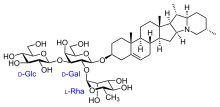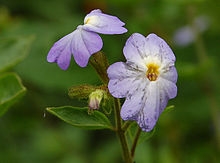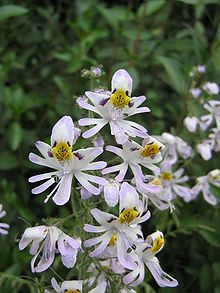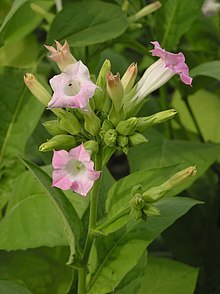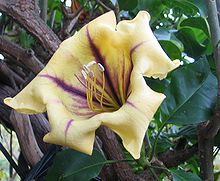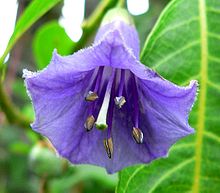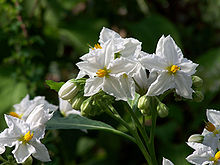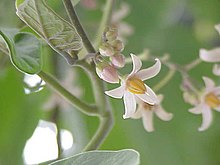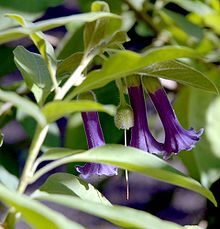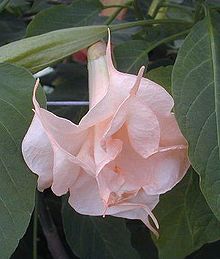Nightshade
The nightshades (Solanaceae Juss.) are a family of herbaceous plants with alternate, simple leaves and without stipules belonging to the order Solanales, of the dicotyledons. It comprises approximately 98 genera and about 2,700 species, with a great diversity of habit, morphology, and ecology. The family is cosmopolitan, being distributed all over the globe with the exception of Antarctica. The greatest diversity of species is found in South America and Central America. This family includes such important food species as potato (Solanum tuberosum), tomato (Solanum lycopersicum), eggplant (Solanum melongena) and chili peppers or peppers (Capsicum). Many very popular ornamentals belong to the Solanaceae, such as Petunia, Schizanthus, Salpiglossis and Datura. Certain species are known worldwide for their medicinal uses, their psychotropic effects or for being poisonous. Last but not least, nightshades include many model organisms for investigating fundamental biological questions at the cellular, molecular, and genetic level, such as tobacco and petunia.
Description

Solanaceae are herbaceous plants, subshrubs, shrubs, trees, or lianas. They can be annual, biennial or perennial, erect or decumbent. They may be provided with underground tubers. They do not have laticifers, latex, or colored juices.[citation required]
They can have a basal or terminal aggregation of leaves or they can have neither type. The leaves are generally alternate or alternate to opposite (ie, alternate at the base of the plant and opposite towards the inflorescence). The consistency of the leaves can be herbaceous, leathery, or they can be transformed into thorns. In general the leaves are petiolate or subsessile, rarely sessile. They are frequently odorless but are sometimes aromatic or fetid. The leaf blade can be simple or compound, in the latter case, they can be triad or pinnatifid. The venation of the leaves is reticulate and they do not have a basal meristem. Regarding leaf anatomy, the blades are generally dorsiventral, without secretory cavities. The stomata are generally confined to one side of the leaves, rarely on both sides.
The flowers are generally hermaphroditic, although there are monoecious, andromonoecious or dioecious species (such as some Solanum or Symonanthus). Pollination is entomophilous. The flowers can be solitary or aggregated in cymose, terminal, or axillary inflorescences. Flowers are medium in size, fragrant (as in Nicotiana), fetid (Anthocercis) or odorless. The flowers are actinomorphic, slightly zygomorphic or markedly zygomorphic (as for example, the flowers with bilabiate corolla in Schizanthus). Irregularities in symmetry may be due to the androecium, the perianth, or both. The flowers in the vast majority of cases present a perianth differentiated into a calyx and corolla (with 5 sepals and 5 petals, respectively), an androecium with 5 stamens and two united carpels forming a gynoecium with a superior ovary (it is said, then, that They are pentameric and tetracyclic. They usually present a hypogynous disc. The calyx is gamosepalous (since the sepals are joined together to form a tube), with 5 (sometimes 4 or 6) segments equal to each other, it is five-lobed, with the lobes shorter than the tube, it is persistent and can be very often be accrescent. The corolla usually has 5 petals that are also joined together to form a tube. The corolla may be bell-shaped, rotated, funnel-shaped, or tubular.
The androecium has 5 stamens (rarely 2, 4 or 6), free from each other, opositisépalos (that is, they alternate with the petals), they are usually fertile or, in some cases (for example, in Salpiglossideae) with staminoids. In the latter case, they can present a single staminoid (Salpiglossis) or 3 (Schizanthus). The anthers can be connivent, touching at their upper end to form a ring, or totally free, dorsifixed or basifixed, bite-shaped, with poricidal dehiscence or through small longitudinal fissures. Due to their poricidal anthers, they require buzz pollination. The stamen filament may be filiform or flattened. The stamens may be inserted into the corolla tube or exserted. Microsporogenesis is simultaneous, the tetrad of microspores is tetrahedral or isobilateral. Pollen grains are bicellular at the time of dehiscence, usually open and collapsing.
The gynoecium is bi-carpellate (rarely 3- or 5-locular), with a superior ovary and two locules. The locules may be secondarily divided by false septa, as in the case of Nicandreae and Datureae. The gynoecium is located obliquely with respect to the median plane of the flower. They have a single style and a single stigma, the latter simple or bilobed. Each loculus bears from 1 to 50 axillary placentation anatropous or hemianatropous ova. The development of the embryo sac can be of the Polygonum type or the Allium type. The polar nuclei of the embryo sac fuse in advance of fertilization. They present 3 antipodes, usually ephemeral, or persistent as in the case of Atropa. The fruit in Solanaceae may be a berry (as in the case of Solanum), a drupe, or a capsule. The capsules are usually septicidal or, rarely, loculicidal or valvar. The seeds are usually endospermous, oily (rarely starchy), without conspicuous hairs. The embryo, which can be straight or curved, has two cotyledons. The basic chromosome numbers range from x=7 to x=12. Many species are polyploid.
The diversity of some Solanaceae characters
Despite the previous description, Solanaceae exhibit great morphological variability, even in reproductive characters. Examples of the accentuated diversity of the family are:
- The number of carpals that make up the gin
In general, all Solanaceae have a gynoecium made up of two carpels. However, there are genera with a single carpelous gynoecium (Melananthus), or with 3 to 4 carpels such as Capsicum, or with 3 to 5 carpels, as in the case of Nicandra , some species of Jaborosa and Trianaea. Finally, there is at least one recorded case of a species (Iochroma umbellatum) that has gynoecium with 4 carpels.
- The number of loops in the ovary
Usually the number of locules in the ovary is equal to the number of carpels. However, there are species in which such numbers are not identical due to the existence of false septa (internal walls that subdivide each loculus), such as Datura and some members of the Lycieae tribe (the genera Grabowskia and Vassobia).
- Types of eggs and their number
In Solanaceae the ovules are, in general, anatropous. However, there are genera with anacampylotropic ovules (example in Phrodus, Grabowskia or Vassobia), hemitropous (Cestrum) or hemicampilotropes (Capsicum, Schizanthus and Lycium). Regarding the number of ovules per locule, in general these are several, sometimes they are few (two pairs in each locule in Grabowskia, one pair in each locule in Lycium) and, exceptionally, a single ovule is found in each locule, as for example, in Melananthus.
- The type of fruit
The fruits in Solanaceae are mostly berries or capsules (including pixidia) and, less frequently, drupes. The berries are typical of the subfamilies Cestroideae, Solanoideae (with the exception of Datura, Oryctus, Grabowskia and the tribe Hyoscyameae) and the tribe Juanulloideae. (with the exception of Markea). The capsules are characteristic of the subfamilies Cestroideae (with the exception of Cestrum) and Schizanthoideae, the tribes Salpiglossoideae, Anthocercidoideae and the genus Datura. The Hyoscyameae tribe has pixidia. The drupes are typical in the Lycieae tribe and in the Iochrominae.
Alkaloids
Alkaloids are nitrogenous bases, produced by plants as secondary metabolites, which present an intense physiological action on animals even at low doses. Among the most famous alkaloids are those present in nightshades, called tropanes. Plants containing these substances have been used for centuries as poisons. However, despite their recognized poisonous effect, many of these substances have valuable pharmaceutical properties. Solanaceae are characterized by having many species that contain various types of more or less active or poisonous alkaloids, such as scopolamine, atropine, hyoscyamine and nicotine. These are found in plants such as henbane (Hyoscyamus albus), belladonna (Atropa belladonna), the chamico or Jimson weed (Datura stramonium), mandrake (Mandragora autumnalis), tobacco and others. Some of the main types of nightshade alkaloids are:
- Solanine: toxic glucoalkaloid of bitter taste that responds to the elemental formula C45H73NO15. It's made up of an alkaloid, the solonidinaAnd a side chain of a carbohydrate. It is naturally found in leaves, fruits and tubers of several solanaceae, such as potato and tomato. It is considered that its production is an adaptive strategy of plants as a defense mechanism against herbivory. Solnin poisoning is characterized by gastrointestinal alterations (diarrhea, vomiting, abdominal pain) and neurological disorders: (alucinations and headache). The toxic dose is 2 to 5 mg per kilogram of body weight. Symptoms manifest from 8 to 12 hours after intake. The content of these glycoalcaloids in the pope, for example, varies significantly depending on the environmental conditions during cultivation, the length of the storage period and the variety considered. The content of glicoalcaloids, on average, is 0.075 mg per gram of potatoes.
- Tropanos. They are bicyclic nitrogenated organic compounds (IUPAC nomenclature: 8-Methyl-8-azabicycle[3.2.1]octane), of elemental chemical formula C8H15N. This type of alkaloids include, among others, atropine and cocaine. These alkaloids are found in several species of solanaceae, such as mandragora (Mandragora autumnalis), Black or crazy grass (Hyoscyamus niger)The beautiful (Atropa belladonna) and the devil (Datura stramonium)). Atropine is the rhythmic form of hiosciamine, comes from the Belladone and is used to dilate the eye pupil during ophthalmological examinations. In fact, the juice of the berries Atropa belladonna was used by Italian courtiers during the Renaissance to exaggerate the size of their eyes by dilating their pupils. Atropine is also a central nervous system stimulant and is used as a treatment for nerve gas poisoning or organophosphorous insecticides. Scopolamine (using of Hyoscyamus muticus and Scopolia atropioids), is another tropane that is used in small doses for the treatment of nausea. Scopolamine and hiosciamine are the most widely used tropical alkaloids in pharmacology and medicine due to their effects on the parasympathetic nervous system. These alkaloids cannot be replaced by any other kind of compounds so their demand continues. This is one of the reasons for the development of a fertile field of research in the metabolism of alkaloids, the enzymes involved and the genes that produce them. Hyosciamine 6-β hydroxylase, for example, is the enzyme that catalyzes hydroxylation of hiosciamine that leads to the production of scopolamine at the end of the biosynthetic path of tropane. This enzyme has been isolated and the corresponding gene has been cloned from three species: Hyoscyamus niger, Atropa belladonna and Brugmansia candida.
- Nicotina. Nicotine (nomenclature IUPAC (S)-3-(1-methylpirrolidin-2-il) piridina) is an alkaloid that occurs in high quantities in the tobacco plant (Nicotiana tabacum), but it is also — at a lower concentration — in other species of solanaceae such as potato, tomato, eggplant and pepper. Its function in plants is to act as a defense against herbivores, being an excellent neurotoxin, particularly against insects. In fact, nicotine has been used for many years as insecticides, its current use being displaced by synthetic molecules derived from its structure. At low concentrations nicotine acts as a stimulant for mammals, this being the cause of dependence on smokers.
- Capsaicin. Capsaicin (nomenclature IUPAC 8-methyl-N-vanillil-trans-6-nonenamide) is an alkaloid that is not structurally related to nicotine or tropanos. It is found in the species of the genus Capsicum, which include popular chilies and habaneros and is the active component that determines the spicy flavor of these spices. The compound is not appreciably toxic to humans. However, it stimulates specific pain receptors in most mammals, especially those related to heat perception in oral mucosa and other epithelial tissues. In contact with these mucosa, the hoodine causes a burning sensation not very different from that of a real fire burn.
Distribution
Although nightshades are found on all continents, the greatest species richness is found in Central and South America. Two other centers of diversity include Australia and Africa. Solanaceae can occupy a wide variety of ecosystems, from deserts to tropical forests, and are often also found in secondary vegetation that colonizes disturbed areas.
Taxonomy
A complete taxonomic synopsis of the Solanaceae, including subfamilies, tribes, and genera, is provided below and is based on the most recent studies on the molecular systematics of the family.
Cestroideae (syn.: Browallioideae)
It is a subfamily characterized by the presence of pericyclic fibers, androecium with 4 or 5 stamens, frequently didynamus. The basic chromosome numbers are highly variable, from x=7 to x=13. The subfamily comprises 8 genera (divided into 3 tribes) and approximately 195 species distributed in America. The genus Cestrum is the most important with respect to the number of species since it includes 175 of the 195 species of the subfamily. The tribe Cestreae has the particularity of including taxa with long chromosomes (from 7.21 to 11.51 µm in length), when the rest of the family, in general, has short chromosomes (such as 1.5 to 3.52 µm in length in Nicotianoideae).
- Tribu Browallieae Hunz. (1995)
- Browallia L. (1754), genus with 6 species distributed in the neotropics to Arizona in the United States.
- Streptosolen Miers (1850)Native monotypical genus of Los Andes.
- Cestreae Tribe Don (1838). It comprises 3 genera of woody plants, usually arbusive.
- Cestrum L. (1753). It includes some 175 species distributed in neotropics.
- Sessea Ruiz " Pav. (1794). Gender with 16 species of Los Andes.
- Vestia Willd. (1809), monotypical genre of Chile.
- Tribu Salpiglossideae (Benth.) Hunz. This tribe includes 2 genera and 6 endemic species from Argentina and Chile.
- Reyesia Gay (1840), comprises 4 species, distributed in Argentina and Chile.
- Salpiglossis Ruiz " Pav. (1794)with two species originating from southern South America.
Goetzeoideae
Subfamily characterized by having fruit in drupes and seeds with curved embryos with large and fleshy cotyledons. The basic chromosome number is x=13. It includes 4 genera and 5 species that are distributed throughout the Greater Antilles. Based on molecular data, some authors include the monotypic genera Tsoala Bosser & D'Arcy (1992), endemic to Madagascar, and Metternichia of southeastern Brazil. Goetzeaceae Airy Shaw is considered a synonym of this subfamily.
- Coeloneurum Radlk. (1890), endemic monotypical genus of La Española.
- Sword Rchb. (1850)with a single kind of Cuba.
- Goetzea Wydler (1830)includes two species of the Antilles.
- Henonia Griseb. (1866), genus with a single species from Cuba.
Petunioideae
Molecular systematics indicates that Petunioideae is the sister clade of the subfamilies with chromosome number x=12 (Solanoideae and Nicotianoideae). They present calisteginas, an alkaloid of the type of tropanes. The androecium is made up of 4 stamens (rarely 5), usually of two different lengths. The basic chromosome numbers in this subfamily can be x=7, 8, 9 and 11. It comprises 13 genera and about 160 species, distributed throughout Central and South America. Based on molecular data, some authors consider that the native Patagonian genera Benthamiella, Combera and Pantacantha form a clade with the category of tribe (Benthamielleae) which should be arranged in the subfamily Goetzeoideae.
- Benthamiella Speg. (1883), includes 12 native species of Patagonia
- Bouchetia Dunal (1852) with 3 neotropical species
- Brunfelsia L. (1753), genus with about 45 species distributed in neotropics
- Combera Sandw. (1936), genus with two Patagonian species
- Fabiana Ruiz " Pav. (1794), genus that includes 15 native species of Los Andes
- Hunzikeria D'Arcy (1976), comprising 3 species from the southwest of the United States and Mexico
- Latua Phil. (1858)with a single species of southern Chile
- Leptoglossis Benth. (1845), genus with 7 species from western South America.
- Nierembergia Ruiz " Pav. (1794), covers 21 South American species.
- Pantacantha Speg. (1902), monospecific genus of Patagonia.
- Calibrachoa Cerv. ex La Llave & Lex.with 32 neotropical species. It has been considered, on morphological data, that this gender should be included within Petunia. However, molecular and cytogenetic evidence indicates that both must remain separate. Actually, Calibrachoa has a basic number of chromosomes x=9, while Petunia It's x=7.
- Petunia (Juss.) Wijsman (1803)with 18 South American species.
- Plowmania Hunz. " Subils (1986), monotypical genus of Mexico and Guatemala.
Schizanthoideae
Includes annual or biennial herbs, with tropane alkaloids, without pericyclic fibers, with hairs and characteristic pollen grains. The flowers are zygomorphic. The androecium has 2 stamens and 3 staminoids, the dehiscence of the anthers is explosive. The embryo is curved. The basic chromosome number is x=10. Schizanthus is a rather atypical genus within the Solanaceae, due to its strongly zygomorphic flowers and its basic chromosome number. Morphological and molecular data indicate that Schizanthus is a sister genus to the other Solanaceae and that it diverged early from the rest of the family, probably in the late Cretaceous or early Tertiary, around 50 million years ago.. The great diversification in the types of flowers in Schizanthus has been the product of the adaptation of the species of this genus to the different groups of pollinators existing in the Mediterranean, high alpine and desert ecosystems of Chile and adjacent areas of Argentina.
- Schizanthus Ruiz et Pav. (1794), comprising 12 species originating from Chile.
Schwenckioideae
Includes annual herbs, with pericyclic fibers, the flowers are zygomorphic, the androecium with 4 stamens, didynamus or with 3 staminoids, the embryo is straight and short. The basic chromosome number is x=12. It includes 4 genera and about 30 species distributed in South America.
- Heteranthia Nees & Mart. (1823) a single species of Brazil
- Melananthus Walp. (1850)includes 5 species from Brazil, Cuba and Guatemala
- Protoschwenckia Soler (1898), monotypical genre of Bolivia and Brazil. According to some molecular systematic studies, this genus has an uncertain taxonomic position within the subfamily.
- Schwenckia L. (1764), covers 22 species distributed in neotropical regions of America.
Nicotianoideae
- Anthocercideae Tribe G.Don (1838). This tribe is endemic to Australia and comprises 31 species distributed in 7 genera. The molecular systematic of the tribe indicates that it is the sister of Nicotiana, gender Anthocercis, Anthotroche, Grammosolenand Symonanthus they're monofiltics, while Cyphanthera and Duboisia they are not (Crenidium is monotypical). It was further inferred that some characters are derivatives within the tribe, such as unilocular stamens, with semicircular opércles, ebracteolated flowers, and berries.
- Anthocercis Labill. (1806), 10 species, Australia
- Anthotroche Endl. (1839), 4 species, Australia
- Crenidium Haegi (1981), monotypical gender, Australia
- Cyphanthera Miers (1853), 9 species, Australia
- Duboisia R.Br. (1810), 4 species, Australia
- Gramnosolen Haegi (1981), 2 species, Australia
- Symonanthus Haegi (1981), 2 species, Australia
- Nicotianeae Tribe Dum. (1827)
- Nicotiana L. (1754), widely distributed genus, with 52 American species, 23 Australians and an African.
Solanoideae
- Tribu Capsiceae Dumort (1827)
- Capsicum L. (1753), a genus that includes some 31 neotropical species.
- Lycianthes (Dunal) Hassler (1917), with some 200 species distributed in America and Asia.
- Tribu Datureae G. Don (1838) is a tribe that presents two perfectly differentiated genres both at morphological and molecular levels. Brugmansia includes tree species, while D. includes herbs or bushes. The latter is divided into three sections: Stramonium, Dutra and Ceratocaulis.
- Brugmansia Persoon (1805), a genus that includes 6 species of Los Andes. (incl.: Methysticodendron Schult. (1955))
- D. L. (1753), with 11 neotropical species.
- Hyoscyameae Endl. (1839)
- Anisodus Link (1825), with 4 species from China, India and the Himalayas.
- Atropa L. (1753), includes 3 Eurasian species.
- Atropanthe Pascher (1909), a monotypical genre of China.
- Hyoscyamus L. (1753), covers about 20 species distributed from the Mediterranean to China.
- Physochlaina G. Don (1838), includes 11 Euro-Asian species.
- Przewalskia Maxim. (1881) with a single species of China.
- Scopolia Jacq. (1764), a gender with disyunta distribution, with a European species and one of Japan.
- Tribe Jaboroseae Miers (1849)
- Jaborosa Juss. (1789), a genus that includes 23 South American species.
- Tribe Solandreae Miers (1849)
- Subtribu Juanulloinae: comprises 10 genera of epiphytic trees and bushes with neotropical distribution. Some of these genres (Dyssochroma, Merinthopodium and Trianaea) show a clear dependence on several bat species for both pollination and dispersion of seeds.
- Dyssochroma Miers (1849), with 2 species from southern Brazil.
- Ectozoma Miers (1849)
- Hawkesiophyton Hunz. (1977)
- Juanulloa Ruiz et Pav. (1794), with 11 species from South and Central America.
- Markea Rich.(1792) gender covering 9 species from South America and Central America.
- Merinthopodium J. Donn. Sm. (1897) includes 3 species from South America.
- Rahowardiana D' Arcy (1973)
- Schultesianthus Hunz. (1977), a genus that includes 8 neotropical species.
- Trianaea Planch. et Linden (1853) with 6 South American species.
- Subtribu Solandrinae, is a monotypical subtribute that differs from Juanulloinae in his embryos with cotiledons and his semi-inferous ovary.
- Solandra Sw. (1787), includes 10 species of neotropical regions of America.
- Subtribu Juanulloinae: comprises 10 genera of epiphytic trees and bushes with neotropical distribution. Some of these genres (Dyssochroma, Merinthopodium and Trianaea) show a clear dependence on several bat species for both pollination and dispersion of seeds.
- Tribe Lycieae Hunz. (1977). It comprises 3 genera of woody plants that grow in arid or semi-arid climates. The cosmopolitan genre Lycium is the oldest of the tribe and the one with the greatest morphological variability. Molecular System Studies suggest that so much Grabowskia Like Phrodus should be included within Lyciumand that this gender Nolana and Sclerophylax they would form a clado (Lyciina), which lacks for the time of taxonomic category. The berry fruit, red, fleshy, scattered by birds, is the type of dominant fruit in Lycium. The different types of fruits in this genus have evolved from the type of berry mentioned above to a drupa with a small number of seeds.
- Grabowskia Schltdl. (1832), 3 South American species.
- Lycium L. (1753), cosmopolitan, includes 83 species.
- Phrodus Miers (1849), endemic in northern Chile, includes 2 species.
- Mandragoreae Tribe (Wettst.) Hunz. " Barboza (1995). This monotypical tribe does not have a systematic position defined as molecular systematic studies suggest.
- Mandragora L. (1753), two species of Eurasia
- Tribe Nicandreae Wettst. (1891), is a tribe with two South American genres. Molecular systematic studies indicate that both genders are not related to each other and also to other family genres, so their taxonomic position is uncertain.
- Exodeconus Raf. (1838), with 6 species from the west of South America.
- Nicandra Adans (1763), which uses only species distributed in neotropical regions.
- Tribu Nolaneae Rchb. (1837)
- Nolana L. (1762) They are herbs or small shrubs in most succulent leaves, have very colorful flowers, ranging from white to several shades of blue, and their fruit is of a schizocarp type, which gives origin to several nuts. It comprises 89 species distributed in western South America.
- Tribe Physaleae Miers (1849), is a great sister tribe of Capsiceae.
- Subtribu Iochrominae (Miers) Hunz. is a nail within the Physaleae tribe that comprises 37 species, mainly distributed in the Andes, assigned to 6 genera. The members of this subtribu are characterized by woody bushes or small trees with attractive tubular or rotated flowers. They also present a great floral diversity covering, in fact, the entire variation in the family. Its flowers can be red, orange, yellow, green, blue, purple or white. The shape of the corolla can be rotated tubular, with a variation of up to 8 times in the length of the tube through the different species.
- Acnistus Schott (1829), with a species distributed in the neotropics.
- Dunalia Kunth. (1818), which includes 5 species of the Andes.
- Iochroma Benth. (1845), genus with 24 species of the Andes.
- Saracha Ruiz et Pav. (1794), which includes 2 species of the Andes.
- Vassobia Rusby (1927), with two South American species.
- Eriolarynx Hunz.(2000), a genus that presents 3 species from Argentina and Bolivia.
- Subtribu Iochrominae (Miers) Hunz. is a nail within the Physaleae tribe that comprises 37 species, mainly distributed in the Andes, assigned to 6 genera. The members of this subtribu are characterized by woody bushes or small trees with attractive tubular or rotated flowers. They also present a great floral diversity covering, in fact, the entire variation in the family. Its flowers can be red, orange, yellow, green, blue, purple or white. The shape of the corolla can be rotated tubular, with a variation of up to 8 times in the length of the tube through the different species.
- Subtribu Physalinae (Miers) Hunz. (2000). It is a monophyllic subtribution that includes 10 genera and includes woody herbs or shrubs with solitary, axillary, yellow, white or purple flowers that are pollinated by bees. Once the pollination occurs, the corollary falls and the chalice expands to cover the entire bay it is developing (the chalice is said to be acrescente). In many species the chalice becomes yellow or orange to maturity. The berries, with many seeds, are greenish to yellow-orange, often with red or purple reflections.
- Brachistus Miers (1849), with 3 species from Mexico and Central America.
- Chamaesaracha (A.Gray) Benth. et Hook. (1896), comprising 10 species from Mexico and Central America.
- Leucophysalis Rydberg (1896), includes 3 species from the Southwest of the United States and Mexico.
- Margaranthus Schlecht. (1830), with a Mexican species.
- Oryctes S. Watson (1871), a monotypical genus of the southwest of the United States.
- Quincula Raf. (1832) with a single species from the southwest of the United States and Mexico.
- Physalis L. (1753), the largest genus of the subtribu, with 85 species distributed in the tropical regions of America and a species of China.
- Witheringia L' Heritier (1788), a genus with 15 species of neotropical regions.
- Tzeltaliasegregated gender Physaliswith two species distributed in Mexico and Guatemala.
- Darcyanthus, genus with a single species from Bolivia and Peru.
- Subtribu Salpichroinae, is a subtribu of Physaleae that includes 16 American species distributed in two genera:
- Nectouxia Kunth. (1818), a Mootypical and Endemic genus of Mexico.
- Salpichroa Miers (1845), a genus with 15 species of the Andes and other regions of Améria del Sur.
- Subtribu Withaninae, is a Physaleae subtribu with a wide distribution, including 9 genres:
- Archiphysalis Kuang (1966), with 3 species from China and Japan.
- Athenaea Sendtn. (1846), which includes 7 species from Brazil.
- Aureliana Sendt. (1846), with 5 species from South America.
- Melissia Hook. f. (1867), a monotypical genus of St. Helena.
- Physalisastrum Makino (1914), with 9 Asian species.
- Tubocapsicum (Wettst.) Makino (1908), with a single endemic species of China.
- Withania Pauq.(1825), with 10 native species of the Canary Islands, Africa and Nepal.
- Cuatresia Hunz. (1977), with 11 neotropical species. Molecular studies indicate that this gender, together with Deprea and Larnax It has an uncertain taxonomic position.
- Deprea Raf. (1838), with 6 neotropical species.
- Larnax Miers (1849), many taxonomers consider it a synonym of Deprea, covers 22 native species of the Andes.
- Subtribu Physalinae (Miers) Hunz. (2000). It is a monophyllic subtribution that includes 10 genera and includes woody herbs or shrubs with solitary, axillary, yellow, white or purple flowers that are pollinated by bees. Once the pollination occurs, the corollary falls and the chalice expands to cover the entire bay it is developing (the chalice is said to be acrescente). In many species the chalice becomes yellow or orange to maturity. The berries, with many seeds, are greenish to yellow-orange, often with red or purple reflections.
- Solaneae tribe (1852). Gender Cyphomandra Sendtn. (1845), Discopodium Hochst. (1844), Normandy Lowe (1872), Triguera Cav. (1786) Lycopersicum Mill has been transferred inside Solanum. The subtribu, then, is composed of two genres:
- Jaltomata Schltdl. (1838), which includes 50 neotropical species.
- Solanum L. (1753), the largest genus of the family and one of the widest of angiospermas, with 1328 species distributed worldwide.
- Genres with doubtful taxonomic position (Incertae sedis)
The following genera are not yet placed in any of the recognized Solanaceae subfamilies.
- Duckeodendron Kuhlmannb (1925), mono-specific genre of the Amazon.
- Parabouchetia Baillon (1888)
- Pauia Deb. & Dutta (1965)
Genuses and distribution of species
The nightshades comprise 98 genera and about 2,700 species. However, this immense richness of species is not evenly distributed among all genera. Thus, the 8 most important genera of the family concentrate more than 60% of the species, as shown in the table below. In fact, only Solanum —the genus that typifies the family— includes almost 50% of all Solanaceae species.
| Gender | Approximate number of species |
|---|---|
| Solanum | 1330 |
| Lycianthes | 200 |
| Cestrum | 150 |
| Nolana | 89 |
| Physalis | 85 |
| Lycium | 85 |
| Nicotiana | 76 |
| Brunfelsia | 45 |
| Estimated number of species in the family | 2700 |
Economic importance
Among the Solanaceae there are food species as important to humans as the potato (Solanum tuberosum), the tomato (Solanum lycopersicum), the chili, chili or pepper (Capsicum annuum) or eggplant (Solanum melongena). Nicotiana tabacum, native to the Americas, is cultivated throughout the world to produce tobacco.
Many nightshades are important weeds in many parts of the world. Their importance lies in the fact that they can be hosts for crop pests or diseases and, therefore, their presence increases yield or quality losses of the harvested product due to such factors. Examples of this are Acnistus arborescens and Browalia americana as hosts of thrips that later damage the associated crop, and certain species of Datura as hosts of thrips. several types of viruses that are then transmitted to cultivated nightshades. Some weed species, such as Solanum mauritianum in South Africa, present such serious ecological and economic problems that studies are underway to determine the Biological control of them through the use of insects.
Several tree or shrub species of nightshades are grown as ornamentals. Examples include Brugmansia x candida ("angel's trumpet"), cultivated for its large pendulous, shaped flowers. trumpet flower, Brunfelsia latifolia, whose highly fragrant flowers change color from purple to white over a period of 3 days. Other shrubby species cultivated for their attractive flowers are Lycianthes rantonnetii (Paraguay jasmine) with blue-violet flowers, Nicotiana glauca ("wild tobacco") yellow flowers. Other ornamental nightshade species and genera include petunia (Petunia × hybrida), Lycium, Solanum, Cestrum, Calibrachoa × hybrida and Solandra. A hybrid has even been obtained between Petunia and Calibrachoa (which constitutes a new notogenus called × Petchoa G. Boker & J. Shaw) that is traded as an ornamental. Many other species, particularly those that produce alkaloids, are used in pharmacology and medicine (Nicotiana, Hyoscyamus, and Datura).
Solanaceae and genomics
Many species in the family, including tobacco and tomato, serve as model organisms for trying to elucidate basic biological questions. One such aspect, Solanaceae genomics, is an international project that attempts to answer the question of how the same common set of genes or proteins can give rise to organisms as morphologically and ecologically different from each other as Solanaceae. A first major objective of this project was to sequence the tomato genome. To do this, each of the 12 chromosomes of the haploid tomato genome was assigned to different sequencing centers in different countries. Thus, chromosomes 1 and 10 corresponded to the United States, 3 and 11 to China, 2 to Korea, 4 to the United Kingdom, 5 to India, 7 to France, 8 to Japan, 9 to Spain and 12 to Italy. The sequencing of the mitochondrial genome was the responsibility of Argentina and the chloroplast genome was sequenced by the European Union.
Contenido relacionado
Cell (disambiguation)
Alkaloid
Commelinidae
